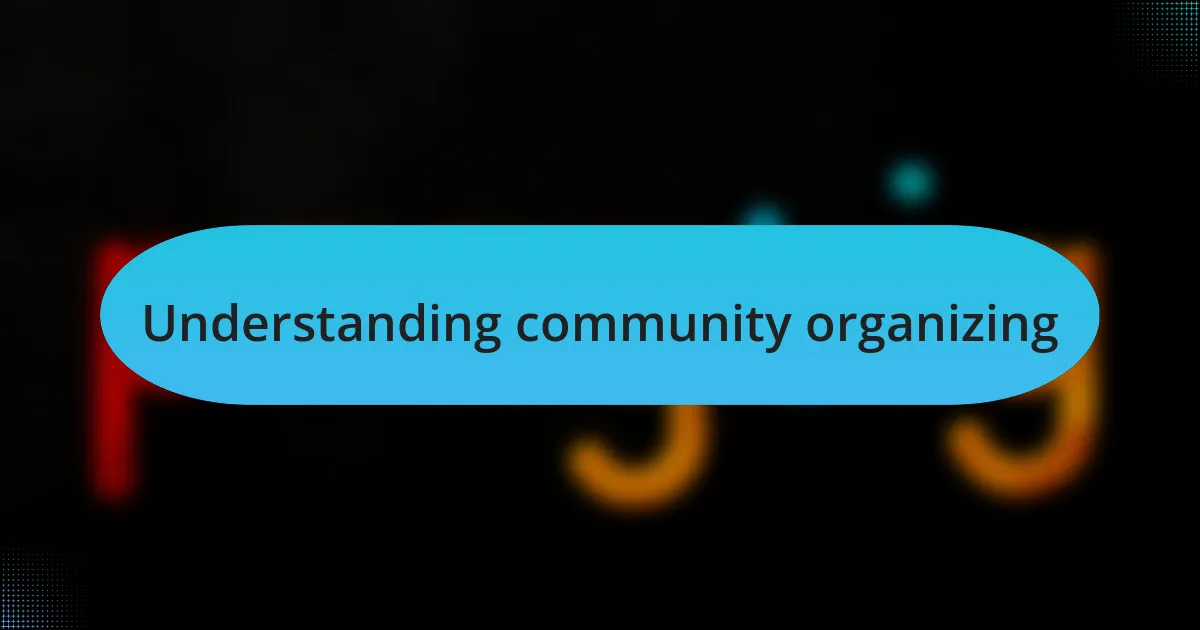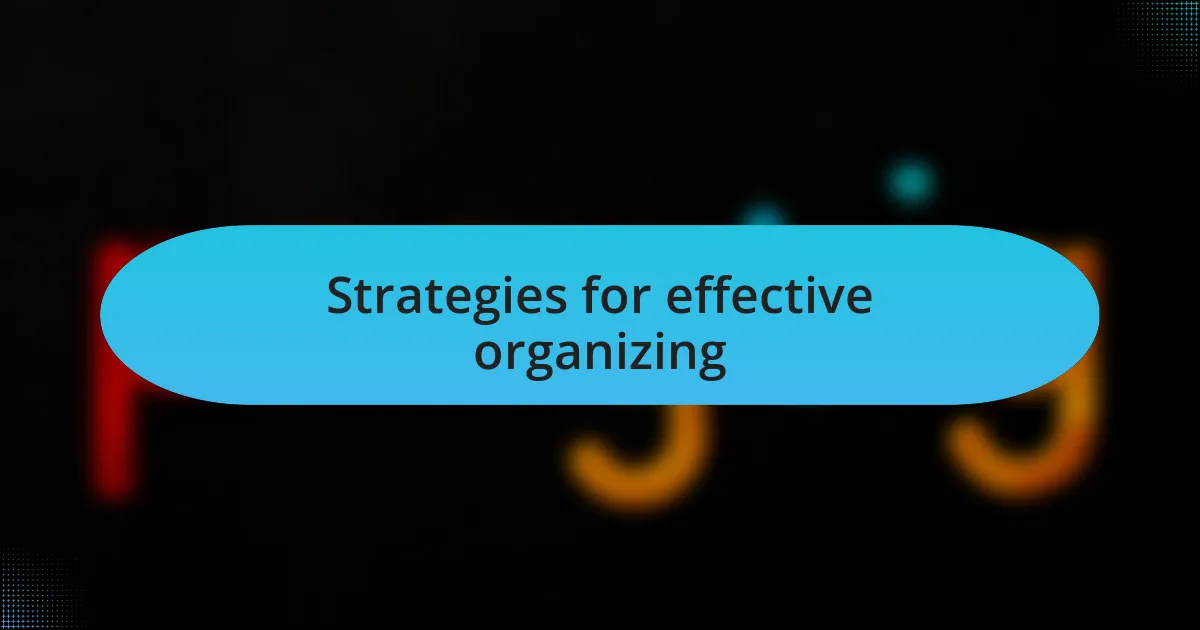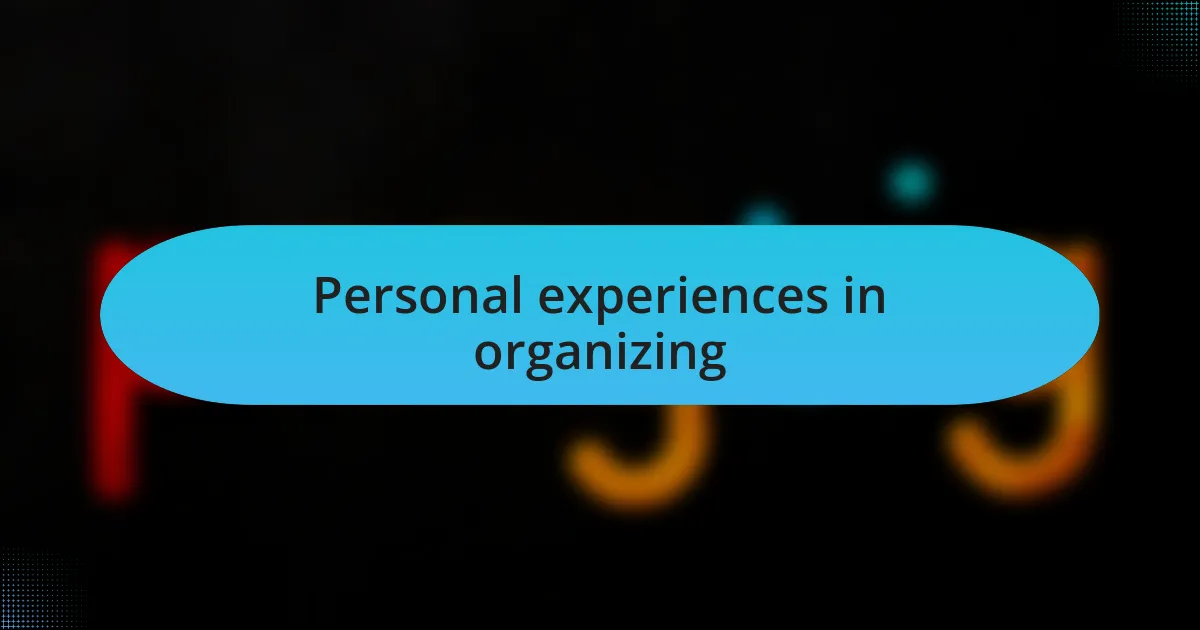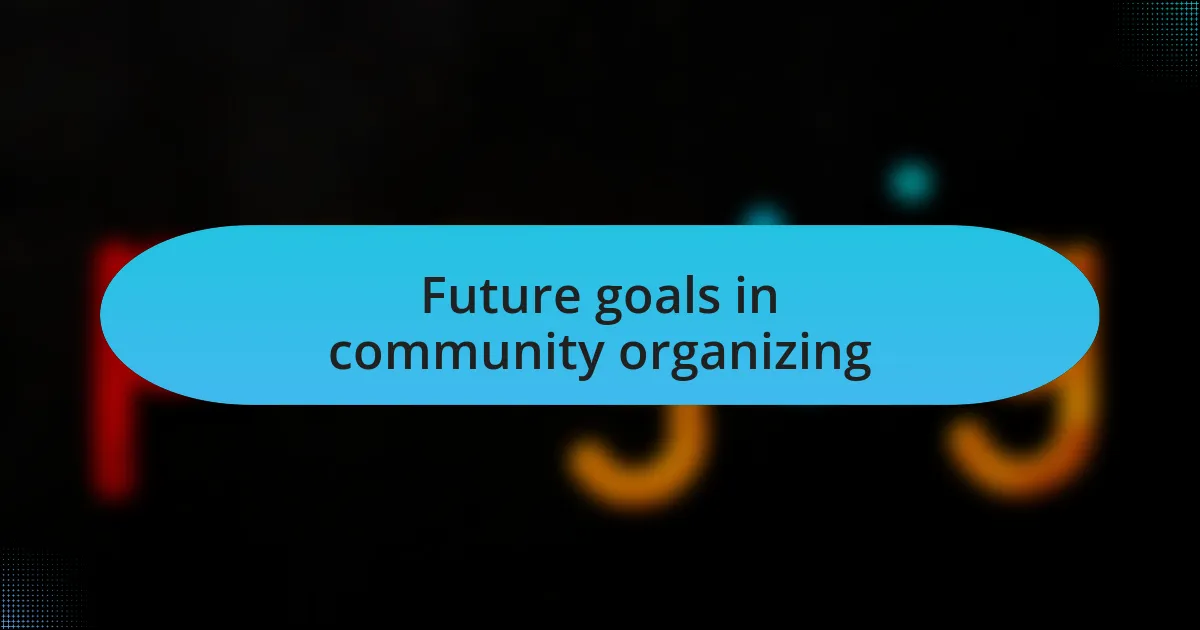Key takeaways:
- Community organizing emphasizes building relationships to empower individuals, fostering trust and collective action.
- Student unions serve as crucial platforms for student advocacy, social interaction, and personal development, enhancing the university experience.
- Effective organizing strategies include strong relationship building, transparent communication, and celebrating small victories to maintain motivation.
- Future goals in community organizing focus on inclusivity, leveraging technology for broader engagement, and mentoring emerging leaders.

Understanding community organizing
Community organizing is all about harnessing the power of individuals to create change. I remember attending my first organizing meeting, feeling a mix of excitement and nervousness. The energy in the room was palpable, as diverse voices came together with a shared purpose. It made me realize that when we unite our strengths and experiences, we can tackle issues that seem insurmountable.
One of the most striking aspects of community organizing is the emphasis on building relationships. I often found that my most meaningful connections emerged in these spaces. Have you ever noticed how sharing a personal story can foster trust and solidarity? Those moments not only deepen our understanding of each other’s struggles but also motivate collective action.
At its core, community organizing is about empowering those who feel unheard. I’ve seen firsthand how one person’s advocacy can inspire a ripple effect. When we come together to amplify our voices, we dismantle barriers and challenge systems that perpetuate inequality. It’s a powerful reminder that every individual’s contribution counts, and together, we can pave the way for a more inclusive society.

Importance of student unions
Student unions play a crucial role in shaping the university experience by providing a space where students can gather, collaborate, and advocate for their needs. I vividly remember my first encounter with my student union—how welcoming it felt and how it sparked a sense of belonging that I had been searching for. Have you ever walked into a room filled with people who share your passions and ambitions? It’s an invigorating feeling that can turn abstract ideas into actionable plans.
These organizations are not just about hosting events; they serve as the frontline for student representation. I’ve seen firsthand how student unions rally together to address concerns ranging from mental health resources to campus safety. When students bring their voices to the table, it can lead to transformative changes in policies that directly impact our lives. Isn’t it empowering to know that our collective efforts can create tangible improvements on campus?
Moreover, student unions foster leadership skills among members, preparing us for future roles in various sectors. I recall being a part of a committee that organized a protest for sustainability initiatives, and the experience taught me invaluable lessons about teamwork and advocacy. How often do university experiences translate into lifelong skills? In essence, student unions not only represent us but also equip us to be proactive agents of change, both during our studies and beyond.

Roles of university student unions
Student unions serve as vital hubs for community engagement and social interaction, bridging gaps between diverse student populations. I remember the first time I attended a meeting where various cultural organizations outlined their plans for the semester. The energy in the room was palpable, and it struck me how these unions play a pivotal role in fostering connections that deepen our understanding of one another. Have you ever noticed how collaboration often sparks creativity?
Advocacy is another core function of student unions, acting as the voice of the student body in university decision-making processes. In my experience, when our union organized a campaign presenting our demands for improved mental health services, it wasn’t just a list of needs; it was a heartfelt plea backed by student stories, which highlighted our challenges and aspirations. This kind of focused action can create a ripple effect, leading to meaningful changes that are truly student-centered.
Additionally, student unions often provide resources and support for both academic and personal development. I once participated in a workshop hosted by our union that focused on improving public speaking skills. Not only did I learn practical techniques, but I also gained the confidence to advocate for issues I cared about—like better accessibility on campus. How many opportunities like this can truly change the way we present ourselves and our ideas to the world? Each of these roles illustrates the multifaceted impact that student unions have on enhancing the overall university experience.

Strategies for effective organizing
One effective strategy for community organizing is building strong relationships within the group. I remember joining a grassroots campaign where we dedicated time not just to plan events, but to sit down and share our backgrounds and motivations. This bonding experience made our collaboration feel genuine and motivated each of us to contribute personally to our goals. Have you ever felt a stronger commitment to a cause when you know the people behind it?
Another important aspect is maintaining clear and consistent communication. During my time with a student union, we utilized social media and regular meetings to ensure everyone felt informed and included. I recall a situation where a miscommunication nearly led to a missed event opportunity, but with proactive updates and check-ins, we turned it around. Isn’t it fascinating how a well-informed team can navigate challenges more effectively?
Lastly, it’s crucial to celebrate small victories. I vividly recall the joy in our group when we successfully organized a campus cleanup; it felt empowering and motivated us to tackle even bigger initiatives. These moments of recognition not only boost morale but also remind us of the impact we’re making collectively. Have you taken time to reflect on the wins, no matter how small, in your own organizing efforts?

Personal experiences in organizing
During my time organizing a fundraising event, I learned firsthand how crucial it is to understand each person’s strengths and weaknesses. One team member was incredibly creative with visuals but struggled with public speaking. I encouraged her to design our promotional materials while pairing her with someone more confident in presentations. Witnessing her shine in her element was a reminder of the power of collaboration. Isn’t it rewarding to see people thrive in roles that fit their unique talents?
I can’t forget the night we hosted a community forum. Initially, the turnout was disappointing, leading to a moment of panic among us organizers. But instead of succumbing to frustration, we engaged attendees in meaningful conversations, asking for their insights on community issues. By transforming the intimate setting into a space for genuine discussion, we not only salvaged the event but also forged deeper connections. How often do we underestimate the impact of one-on-one dialogues in group settings?
A memorable lesson in resilience came when our campaign faced unexpected opposition. Rather than retreating, our team gathered to share feelings of frustration. After openly discussing our shared vision, we emerged with renewed determination and even more innovative strategies. Sometimes, setbacks can reignite passion and creativity in ways we hadn’t anticipated. Have you ever discovered strength in vulnerability during a challenge?

Lessons learned from organizing
When organizing a community cleanup, I quickly learned that preparation goes beyond logistics. I remember arriving at the site to find it littered with not just trash but also scattered anxieties about the task ahead. As we divided into small groups, I noticed how vital it was to create a supportive atmosphere. After encouraging my team to share their thoughts, we developed a rhythm that turned what could have been a chore into a collective celebration. Isn’t it fascinating how addressing emotional barriers can lead to surprisingly productive outcomes?
Another crucial lesson surfaced during a planning meeting for a campus-wide awareness campaign. We had high aspirations, but as ideas were tossed around, I felt a growing sense of overwhelm in the room. Rather than trying to push through with our original agenda, I suggested we take a step back and prioritize a few key ideas. Simplifying our focus reignited our enthusiasm and allowed us to execute a campaign that resonated more deeply with our peers. How often do we complicate our visions instead of honing them to their essence?
I won’t forget the time we attempted to partner with local businesses for sponsorships. Many said no, which, at first, knocked the wind out of our sails. Yet, during a brainstorming session, I encouraged the team to reflect on the feedback and rethink our approach. This pivot led us to explore non-traditional partnerships that ultimately turned into valuable connections. It made me realize that rejection isn’t the end; it can often be the springboard to new opportunities. Have you ever turned a setback into a stepping stone for something greater?

Future goals in community organizing
As I look toward the future of community organizing, I envision a more inclusive approach. In my experience, engaging diverse voices has always enriched the outcome and led to innovative solutions. I once facilitated a workshop where individuals from various backgrounds shared their stories. The cross-pollination of ideas not only resulted in a powerful campaign but also fostered genuine connections among participants. How can we ensure that everyone feels their voice matters in our efforts?
Another goal I am passionate about is integrating technology into our organizing strategies. I remember the excitement during a virtual meeting where we used collaborative tools to tackle issues together. This digital engagement allowed us to connect with students who couldn’t be physically present. It made me realize that by leveraging technology, we can broaden our reach and enhance participation. Have you ever considered how much more effective community organizing could be with the right tech tools at our disposal?
Lastly, nurturing future leaders in community organizing is essential to sustaining our efforts. Taking on mentorship roles has always been rewarding for me, as I’ve seen how supportive guidance can ignite passion in newcomers. I recall a time when I helped a shy student find their footing in planning a local event; their transformation was incredible. How can we create an environment where emerging leaders feel empowered to rise?